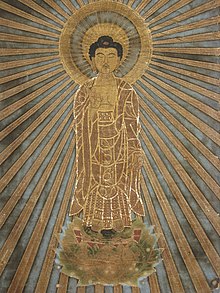Other power
praṇidhāna-vaśa), the latter referring to a Buddha's past bodhisattva vows (purvapraṇidhāna) which have a certain power to influence sentient beings.
Thus, the Lokānuvartanā sūtra, one of the few surviving Mahāsāṃghika sources, states that "the wisdom, the merits and the power of the Buddha are immeasurable.
[12] Likewise, Vasumitra's Wheel of the Formation of Doctrinal Divisions (translated by Xuanzang) states that a central tenet of the Mahāsāṃghikas was that "the material body (rūpakāya), supernatural power (prabhāva) and lifespan (āyus) of a Buddha is unlimited (ananta).
[16] The Mahāvastu, one of the few surviving Mahāsāṃghika texts, states:The purity of the Buddha is so great that the worship of the Exalted One is sufficient for the attainment of Nirvāna, and that one already acquires endless merit by merely walking round a stupa and worshipping it by means of floral offerings...from the Buddha’s smile, there radiate beams which illuminate the entire buddhafields.
According to Robert H. Sharf, terms like buddhādhiṣṭhāna and buddhānubhāva "are ubiquitous in Buddhist materials, where they denote the incursion of the divine into the mundane realm".
One common listing is the ten powers (daśabala), which are discussed in sources like the Mahāsīhanāda-sutta (Majjhima-nikāya) which also has a Chinese parallel in the Foshuo shenmao xishu jing 佛説身 毛喜豎經 (T 17 592c–593b).
For example, the initial chapter of the Aṣṭasāhasrikā states:Whatever, Venerable Sariputra, the Lord’s Disciples teach, all that is to be known as the Tathagata’s work.
[28]The Aṣṭasāhasrikā also states the Buddha's power sustains and supports bodhisattvas as they practice the path:[29] Sariputra: It is through the Buddha's might [anubhava], sustaining power [adhisthana] and grace [parigraha] that bodhisattvas study this deep perfection of wisdom, and progressively train in Thusness?The Bhagavan: So it is, Sariputra.
The Dà zhìdù lùn (Mahāprajñāpāramitopadeśa) states: The power of the Buddha (buddhabala) is immeasurable (apramāṇa): it is a trifle for him to save the beings of the three-thousandfold world system (trisāhasramahāsāhasralokadhātu).
In one passage, the ancient Buddha Prabhutaratna mentions how he made a vow long in the past that a stupa containing his bodily relics would have the power to manifest in all the worlds where the Lotus Sutra was being taught.
[20] The Buddha later radiates beams of light from the ūrṇā between his eyebrows which causes the bodhisattvas in his retinue to see all buddhafields in the entire Dharma realm.
"[35] Furthermore, the Laṅka also explains that the reason the Buddhas bestow their sustaining power on the bodhisattvas is in order to protect them from falling back into bad states, wrong views, or into the path of Śrāvakayāna.
[37] Mantrayana ritual theory generally held that the use of esoteric practices like mantras and mudras allowed the tantric practitioner to reproduce and embody the power of the Buddhas.
For example, according to the Root Manual of the Rites of Mañjuśrī, a Mantrayana ritual text:The power of all the buddhas, and the bodhisattvas who are full of wisdom, manifests itself as an accomplishment in all activities that involve the mantras.
[39] According to Charles B. Jones, the terms “other-power” (tālì 他力) and “self-power” (zìlì 自力) are fundamental to the tradition of Pure Land Buddhism.
Understanding the relationship between one's individual efforts and the power of Amitābha Buddha is one of the "most central and enduring preoccupations" of Pure land Buddhist thought.
[22] Thus, he writes:On the path of easy practice, one simple aspires to the born in the Pure Land with faith in the Buddha as the cause.
This view soon became very popular, becoming a central teaching of Pure Land Buddhism in China and on the East Asian mainland in general.
The Huayan Patriarch Zhiyan (c. 602–668) says in his Souxuan ji 搜玄記 (Record of Searching the Mysteries) that the divine power of the Buddha cannot be received through self-power.
This Huayan view of the necessity of both self and other power is also defended by Fazang (643–712) in his Tanxuan ji 探玄記 (Record of Exploring the Mysteries).
[45] This is understood as a relationship which occurs when, through their own efforts, a practitioner stimulates or affects (gǎn) a Buddha's power, which expresses itself as a compassionate response (yìng).
[47] Yuán Hóngdào (1568–1610) uses various similes to describe this resonance, such as how "one mighty wind produces its howling noise in dozens of small apertures.
"[45] The doctrine of "sympathetic resonance" was also used outside of the Pure Land tradition as well, including by figures like the Sanlun scholar Jizang.
"[51] The traditions of Japanese Pure Land Buddhism put a special emphasis on relying exclusively on Amitābha Buddha's "other power" (Jp: tariki) as the only sure path to Buddhahood.
Even a lowly and vulgar man who joins the caravan of a universal sovereign (cakravatin) will be able to traverse the four continents in a day.
[53]According to Hōnen, it is because of its focused reliance on the Buddha's power that the Pure land path of the nembutsu is the "easy" practice.
It is really only in the works written by Hōnen's disciples like Shōku, Ryūkan, Shōkō (Benchō) and Seikaku, that the term tariki (other-power) becomes a major topic of debate and discussion.
[55] This total selfless entrusting in which the Buddha wisdom unfolds spontaneously and naturally (自然, Jp: jinen, Ch: ziran) is also called shinjin.
In the esoteric Shingon tradition, the idea of the Buddha's power to influence practitioners was discussed since the time of Kūkai (774–835) through the tantric understanding of adhiṣṭhāna.
[59] An influential passage in Kūkai's Sokushin jobutsugi (Principle of Attaining Buddhahood with the Present Body) describes the process of adhiṣṭhāna as one in which the Buddha's radiance is reflected in the practitioner's mind:The word adhiṣṭhāna [Ch: jiachi, 'adding and holding'] demonstrates the universal compassion [that is 'added' by] the tathagatas and the mind of faith [that is held by] beings.




